The Fluid Evolution and Metallogenic Processes of the Liba Gold Deposit, West Qinling, China: Insights from the Texture, Trace Elements, and H-O Isotope Geochemistry of Quartz
Abstract
1. Introduction
2. Regional and Ore Deposit Geology
3. Quartz Petrography
- (1)
- Pre-mineralization quartz veins (Qz0) are typically represented by those found in the south wall of the Magou pit, specifically within the tectonic fracture zone outside the ore body. These veins, stretched by tectonic activity into a hook shape (Figure 4a), range from 4 to 7 m in length and are composed of coarse-grained, milky-white quartz. They are crosscut by fine sulphide-bearing veins, suggesting that the formation of Qz0 predates gold-related mineralization (Figure 4b). These quartz veins are dominated by quartz with traces of pyrite and pyrrhotite. Microscopic observation reveals that the quartz is coarse-grained and often displays pronounced undulatory extinction due to stress-induced deformation (Figure 4c).
- (2)
- Early-metallogenic-stage quartz veins (Qz1) typically occur as a web-like arrangement of veins within the phyllitic slate, which is later crosscut by the main- and late-metallogenic-stage quartz veins (Figure 4d). Compared with the main metallogenic-stage quartz (Qz2), Qz1 quartz is fine-grained, with straight vein edges, and contains a more homogeneous, fine-grained texture (Figure 4e).
- (3)
- Post-mineralization-stage quartz veins (Qz4) are large-grained and contain carbonates but no sulfides. The vein margins are straight (Figure 4j), and these veins were deposited late in the evolution of the hydrothermal system, cutting through all the pre-existing fine veins.
4. Samples and Analytical Methods
4.1. Sampling Selection
4.2. Quartz SEM-CL Imaging
4.3. LA-ICPMS
4.4. Hydrogen and Oxygen Isotope
5. Results
5.1. Quartz Generations and SEM-CL Imaging
5.2. Trace Elements
5.3. Hydrogen and Oxygen Isotopes of Quartz
6. Discussion
6.1. The Characteristics and Genesis of the Liba Gold Deposit
6.1.1. Magmatic–Hydrothermal Attribution of the Liba Gold Deposit
6.1.2. Medium- to Low-Temperature Characteristics of the Liba Gold Deposit
6.2. Fluid Evolution and Metallogenic Mechanism
6.2.1. Substitution Mechanism of Trace Elements into Quartz
6.2.2. Advantages of Combined SEM-CL and LA-ICPMS Measurements
6.2.3. Evolution of Mineralizing Fluids
7. Conclusions
- (1)
- The Liba gold deposit is a medium- to low-temperature orogenic gold deposit. The gold enrichment process was primarily driven by a hydrothermal system, with variations in fluid composition during mineralization playing a key role in the gold concentration.
- (2)
- The ore-forming fluid exhibits significant temperature variation and cyclical disturbances during mineralization. SEM-CL imaging identifies five distinct quartz stages, each reflecting rapid changes in fluid properties and disturbances during the mineralization process. The main quartz stages during mineralization include the early-stage Qz1, the primary-metallogenic-stage Qz2 (divided into Qz2a and Qz2b), and the late-stage Qz3, followed by the post-mineralization-stage Qz4.
- (3)
- The ore-forming fluid of the Liba gold deposit underwent a multi-stage evolution from magmatic to metamorphic hydrothermal fluids. Based on the analysis of quartz trace elements (e.g., Al/Ti, Ge/Al ratios), fluid homogenization temperatures, and isotope data (δ18O = 8.25‰ to 12.67‰ and δD = −119.1‰ to −79.8‰), it is evident that the ore-forming fluids originated from a mixture of magmatic hydrothermal fluids and formation water, with a later-stage influence from the metamorphic water.
Supplementary Materials
Author Contributions
Funding
Data Availability Statement
Acknowledgments
Conflicts of Interest
References
- Groves, D.I.; Goldfarb, R.J.; Gebre-Mariam, M.; Hagemann, S.G.; Robert, F. Orogenic gold deposits: A proposed classification in the context of their crustal distribution and relationship to other gold deposit types. Ore Geol. Rev. 1998, 13, 7–27. [Google Scholar] [CrossRef]
- Goldfarb, R.J.; Groves, D.I. Orogenic gold: Common or evolving fluid and metal sources through time. Lithos 2015, 233, 2–26. [Google Scholar] [CrossRef]
- Huang, J.; Wang, J.Y.; Wei, L.M. Geological characteristics and genesis of the Liba gold deposit, Gansu province. Miner. Depos. 2000, 19, 105–115. [Google Scholar]
- He, C.G. Geology, Mineralization, and Genesis of Typical Gold Deposits in the Northern Belt of the West Qinling Orogen. Ph.D. Thesis, China University of Geosciences, Wuhan, China, 2022. [Google Scholar]
- Zhang, Z.H.; Mao, J.W.; Wang, Y. Characteristics of fluid inclusions in the gold deposits within Zhongchuan area‚ western Qinling and their geological significance. Acta Petrol. Mineral. 2004, 23, 147–157. [Google Scholar]
- Liu, J.J.; Liu, C.H.; Wang, J.P.; Zhu, L.M.; Zhang, J.; Zhai, D.G.; Wang, Y.H.; Liu, Z.J.; Zhang, F.F. Classification and mineralization of the gold deposits in the western Qinling region, China. Earth Sci. Front. 2019, 26, 1–16. [Google Scholar]
- Chen, Y. Mineral source of the Li Ba gold deposit in West Qinling. Northwest. Geol. 1994, 15, 5–9. [Google Scholar]
- Yang, G.S.; Chen, Y.W.; Xu, Y.L. Relationship between F1 fault and metallogenesis in Liba gold deposit. Gansu Sci. Technol. 2007, 23, 113–115. [Google Scholar]
- Mao, J.W.; Qiu, Y.M.; Goldfarb, R.J.; Zhang, Z.C.; Garwin, S.; Ren, F.S. Geology, distribution, and classification of gold deposits in the western Qinling belt, central China. Miner. Depos. 2002, 37, 352–377. [Google Scholar] [CrossRef]
- Feng, J.Z.; Wang, D.B.; Wang, X.M.; Zeng, Y.S.; Li, T.F. Magmatic gold mineralization in the western Qinling Orogenic Belt: Geology and metallogenesis of the Baguamiao, Liba and Xiaogouli Gold Deposits. Acta Geol. Sin. 2004, 78, 529–533. [Google Scholar]
- Cheng, Y. A Study on the Relationship Between Structural and Magmatic Activity and Micro-Disseminated Gold Deposits Mineralization in Zhongchuan Area, West Qinling. Master’s Thesis, Geology Department of Northwest University, Xi’an, China, 2001. [Google Scholar]
- Yang, S.C. A Study on the Intermediate-Acidic Magmatic Activity and Au Metallogenesis in Zhongchuan Area, West Qinling. Ph.D. Thesis, China University of Geosciences (Beijing), Beijing, China, 2017. [Google Scholar]
- Chi, G.; Diamond, L.W.; Lu, H.; Lai, J.; Chu, H. Common problems and pitfalls in fluid inclusion study: A review and discussion. Minerals 2021, 11, 7. [Google Scholar] [CrossRef]
- Smith, J.V.; Stenstrom, R.C. Electron-Excited Luminescence as a Petrologic Tool. Geology 1965, 73, 627–635. [Google Scholar] [CrossRef]
- Sippel, R.F. Sandstone petrology, evidence from luminescence petrography. J. Sediment. Res. 1968, 38, 530–554. [Google Scholar] [CrossRef]
- Rusk, B.G. Cathodoluminescent Textures and Trace Elements in Hydrothermal Quartz. In Quartz: Deposits, Mineralogy and Analytics; Springer: Berlin/Heidelberg, Germany, 2012; pp. 307–329. [Google Scholar]
- Hong, J.X.; Zhai, D.G.; Keith, M. Quartz texture and the chemical composition fingerprint of ore-forming fluid evolution at the Bilihe porphyry Au deposit, NE China. Am. Mineral. 2024, 109, 1203–1219. [Google Scholar] [CrossRef]
- Landtwing, M.R.; Pettke, T. Relationships between SEM-cathodoluminescence response and trace-element composition of hydrothermal vein quartz. Am. Mineral. 2005, 90, 122–131. [Google Scholar] [CrossRef]
- Jacamón, F.; Larsen, R.B. Trace element evolution of quartz in the charnockitic Kleivan granite, SW-Norway: The Ge/Ti ratio of quartz as an index of igneous differentiation. Lithos 2009, 107, 281–291. [Google Scholar] [CrossRef]
- Dong, Y.P.; Santosh, M. Tectonic architecture and multiple orogeny of the Qinling Orogenic Belt, Central China. Gondwana Res. 2016, 29, 1–40. [Google Scholar] [CrossRef]
- Zeng, Q.T.; McCuaig, T.C.; Hart, C.J.R.; Jourdan, F.; Muhling, J.; Bagas, L. Structural and geochronological studies on the Liba goldfield of the West Qinling Orogen, Central China. Miner. Depos. 2012, 47, 799–819. [Google Scholar] [CrossRef]
- Ke, C.H.; Wang, X.X.; Yang, Y.; Tian, Y.F.; Li, J.B.; Nie, Z.R.; Lü, X.Q.; Wang, S.A.; Gong, M.Q. Petrogenesis of dykes and its relationship to gold mineralization in the western Qinling Belt: Constraints from zircon U-Pb age, geochemistry and Nd-Hf-S isotopes of Liba gold deposit. Miner. Depos. 2020, 39, 42–62. [Google Scholar]
- Chen, Y.; Wang, Y.W.; Luo, J.X.; Li, D.D.; Wang, J.P.; Long, L.L.; Zhang, H.Q.; Geng, J. Characteristics and genesis of gold-bearing sulfide in the Liba gold deposit, West Qinling. Acta Petrol. Sin. 2025, 41, 1387–1405. [Google Scholar] [CrossRef]
- Exploration Report of the Liba Gold Deposit, Lixian County, Gansu Province; Longnan Zijin Mining Co., Ltd.: Longnan, China, 2017.
- Wang, F.Y.; Ge, C.; Ning, S.Y.; Nie, L.Q.; Zhong, G.X.; White, N. A new approach to LA-ICP-MS mapping and application in geology. Acta Petrol. Sin. 2017, 33, 3422–3436. [Google Scholar]
- Shen, J.; Qin, L.; Fang, Z.; Zhang, Y.; Liu, J.; Liu, W.; Wang, F.; Xiao, Y.; Yu, H.; Wei, S. High-temperature inter-mineral Cr isotope fractionation: A comparison of ionic model predictions and experimental investigations of mantle xenoliths from the North China Craton. Earth Planet. Sci. Lett. 2018, 499, 278–290. [Google Scholar] [CrossRef]
- Liu, Y.S.; Gao, S.; Hu, Z.C.; Gao, C.G.; Zong, K.Q.; Wang, D.B. Continental and oceanic crust recycling-induced melt-peridotite interactions in the Trans-North China Orogen: U-Pb dating, Hf isotopes and trace elements in zircons from Mantle Xenoliths. J. Petrol. 2010, 51, 537–571. [Google Scholar] [CrossRef]
- Liu, Y.S.; Hu, Z.C.; Gao, S.; Günther, D.; Xu, J.; Gao, C.G.; Chen, H.H. In situ analysis of major and trace elements of anhydrous minerals by LA-ICP-MS without applying an internal standard. Chem. Geol. 2008, 257, 34–43. [Google Scholar] [CrossRef]
- Gong, B.; Zheng, Y.F.; Chen, R.X. An online method combining a thermal conversion elemental analyzer with isotope ratio mass spectrometry for the determination of hydrogen isotope composition and water concentration in geological samples. Rapid Commun. Mass Spectrom. 2007, 21, 1386–1392. [Google Scholar] [CrossRef]
- Clayton, R.N.; Mayeda, T.K. The use of bromine pentafluoride in the extraction of oxygen from oxides and silicates for isotopic analysis. Geochim. Cosmochim. Acta 1963, 27, 43–52. [Google Scholar] [CrossRef]
- Kerrich, R.; Goldfarb, R.; Groves, D.; Garwin, S.; Jia, Y.F. The characteristics, origins, and geodynamic settings of supergiant gold metallogenic provinces. Sci. China Ser. D Earth Sci. 2000, 43, 1–68. [Google Scholar] [CrossRef]
- Zhang, F.X.; Zong, J.T.; Ma, J.Q. A tentative discussion on the Carlin-type gold deposits in Qinling and related problems. Miner. Depos. 1998, 17, 77–89. [Google Scholar]
- Zhang, F.X.; Ji, J.L.; Long, L.L.; Fan, C.H. Comparative features of Carlin-para-Carlin type gold deposits in the South Qinling and gold deposits in other areas. Geol. Rev. 2001, 47, 492–499. [Google Scholar]
- Chen, Y.J.; Zhang, J.; Zhang, F.X.; Pirajno, F.; Li, C. Carlin and Carlin-like Gold Deposits in Western Qinling Mountains and Their Metallogenic Time, Tectonic Setting and Model. Geol. Rev. 2004, 50, 134–152. [Google Scholar]
- Zhu, L.M.; Zhang, G.W.; Li, B.; Guo, B. Main Geological Events, Genetic Types of Metallic Deposits and Their Geodynamical Setting in the Qinling Orogenic Belt. Bull. Mineral. Petrol. Geochem. 2008, 27, 384–390. [Google Scholar]
- Deng, J.; Wang, Q.F. Gold mineralization in China: Metallogenic provinces, deposit types and tectonic framework. Gondwana Res. 2016, 36, 219–274. [Google Scholar] [CrossRef]
- Liu, J.J.; Liu, C.H.; Carranza, E.J.M.; Li, Y.J.; Mao, Z.H.; Wang, J.P.; Wang, Y.H.; Zhang, J.; Zhai, D.G.; Zhang, H.F.; et al. Geological characteristics and ore-forming process of the gold deposits in the western Qinling region, China. J. Asian Earth Sci. 2015, 103, 40–69. [Google Scholar] [CrossRef]
- Wang, Y.W.; Ye, T.Z.; Wang, J.B.; lü, Z.C.; Wei, C.S.; Liao, Z.; Zhang, H.Q. Main metallogenetic geological processes and conventional deposit types in China. Miner. Explor. 2014, 5, 111–123. [Google Scholar]
- Yao, S.Z.; Ding, Z.J.; Zhou, Z.G.; Hu, X.L. Ore-accumulating structural system and mineral exploration. Earth Sci. 2020, 45, 4389–4398. [Google Scholar]
- Xue, J.L.; Pang, Z.S.; Cheng, Z.Z.; Chen, H.; Zhang, X.F.; Jia, R.Y.; Yu, B.; Mou, N.N. Geological model for prospecting and prediction of medium to low temperature magmatic-hydrothermal gold deposits. Acta Petrol. Sin. 2025, 41, 4–30. [Google Scholar]
- Wang, Y.; Qiu, K.F.; Müller, A.; Hou, Z.L.; Zhu, Z.H.; Yu, H.C. Machine learning prediction of quartz forming-environments. J. Geophys. Res. Solid Earth 2021, 126, e2021JB021925. [Google Scholar] [CrossRef]
- Zhang, J. Study of Mineralization Process and Mechanism in Baguamiao Super Large Gold Deposit, Fengtai Ore Region, Shaanxi, China. Ph.D. Thesis, Chinese Academy of Geological Sciences, Beijing, China, 2018. [Google Scholar]
- Ding, L.L. Geological-Geochemical Characteristics and Metallogenic Background of Gold Deposits in the South Qinling Orogen: A Case Study of Baguamiao, Maanqiao and Xiajiadian Gold Deposits. Ph.D. Thesis, Geology Department of Northwest University, Xi’an, China, 2022. [Google Scholar]
- Lu, Y.M.; Li, H.G.; Chen, Y.G.; Zhang, G.L.; Zhang, Y.J.; Li, Z.Y. Geological and geochemical features and origin of Zhaishang gold deposit in the Minxian county, Gansu. Geol. Prospect. 2006, 42, 25–31. [Google Scholar]
- Taylor, H.P. The Application of Oxygen and Hydrogen Isotope Studies to Problems of Hydrothermal Alteration and Ore Deposition. Econ. Geol. 1974, 69, 843–883. [Google Scholar] [CrossRef]
- Li, J.; Chen, Y.J.; Li, Q.Z.; Mao, S.D.; Qin, Y.; Guo, J.H.; Nan, Z.L.; Yang, R.S. The C-H-O isotope systematics of the Yangshan gold deposit, Gansu and its implication for the ore-fluid origin. Acta Petrol. Sin. 2008, 24, 817–826. [Google Scholar]
- Götze, J.; Plötze, M.; Graupner, T.; Hallbauer, D.K.; Bray, C.J. Trace clement incorporation into quartz: A combined study by ICP-MS, electron spin resonance, cathodoluminescence, capillary ion analysis, and gas chromatography. Geochim. Cosmochim. Acta 2004, 68, 3741–3759. [Google Scholar] [CrossRef]
- Audétat, A.; Garbe-Schönberg, D.; Kronz, A.; Pettke, T.; Rusk, B.; Donovan, J.J.; Lowers, H.A. Characterisation of a Natural Quartz Crystal as a reference material for microanalytical determination of Ti, Al, Li, Fe, Mn, Ga and Ge. Geostand. Geoanal. Res. 2014, 39, 171–184. [Google Scholar] [CrossRef]
- Rakov, L.T. Role of germanium in isomorphic substitutions in quartz. Geochem. Int. 2015, 53, 171–181. [Google Scholar] [CrossRef]
- Müller, A.; Herklotz, G.; Giegling, H. Chemistry of quartz related to the Zinnwald/Cínovec Sn-W-Li greisen-type deposit, Eastern Erzgebirge, Germany. J. Geochem. Explor. 2018, 190, 357–373. [Google Scholar] [CrossRef]
- Rusk, B.G.; Lowers, H.A.; Reed, M.H. Trace elements in hydrothermal quartz; relationships to cathodoluminescent textures and insights into vein formation. Geology 2008, 36, 547–550. [Google Scholar] [CrossRef]
- Donovan, J.J.; Lowers, H.A.; Rusk, B.G. Improved electron probe microanalysis of trace elements in quartz. Am. Mineral. 2011, 96, 274–282. [Google Scholar] [CrossRef]
- Götze, J. Chemistry, textures and physical properties of quartz-geological interpretation and technical application. Mineral. Mag. 2009, 73, 645–671. [Google Scholar] [CrossRef]
- Götze, J.; Pan, Y.; Müller, A. Mineralogy and mineral chemistry of quartz: A review. Mineral. Mag. 2021, 85, 639–664. [Google Scholar] [CrossRef]
- Larsen, R.B.; Henderson, I.; Ihlen, P.M.; Jacamon, F. Distribution and petrogenetic behaviour of trace elements in granitic pegmatite quartz from south Norway. Contrib. Miner. Petrol. 2004, 147, 615–628. [Google Scholar] [CrossRef]
- Jourdan, A.L.; Vennemann, T.W.; Mullis, J.; Ramseyer, K.; Spiers, C.J. Evidence of growth and sector zoning in hydrothermal quartz from Alpine veins. Eur. J. Mineral. 2009, 21, 219–231. [Google Scholar] [CrossRef]
- Götte, T.; Pettke, T.; Ramseyer, K.; Koch-Müller, M.; Mullis, J. Cathodoluminescence properties and trace element signature of hydrothermal quartz: A fingerprint of growth dynamics. Am. Mineral. 2011, 96, 802–813. [Google Scholar] [CrossRef]
- Götze, J.; Plötze, M.; Fuchs, H.; Habermann, D. Defect structure and luminescence behaviour of agate; results of electron paramagnetic resonance (EPR) and cathodoluminescence (CL) studies. Mineral. Mag. 1999, 63, 149–163. [Google Scholar] [CrossRef]
- Jourdan, A.L.; Vennemann, T.W.; Mullis, J.; Ramseyer, K. Oxygen isotope sector zoning in natural hydrothermal quartz. Mineral. Mag. 2009, 73, 615–632. [Google Scholar] [CrossRef]
- Müller, A.; Kronz, A.; Breiter, K. Trace elements and growth patterns in quartz: A fingerprint of the evolution of the subvolcanic Podlesí Granite System (Krušné Hory, Czech Republic). Vestn. Ceskeho Geol. Ustavu 2002, 77, 135–145. [Google Scholar]
- Heinrich, C.A.; Driesner, T.; Stefánsson, A.; Seward, T.M. Magmatic vapor contraction and the transport of gold from the porphyry environment to epithermal ore deposits. Geology 2004, 32, 761–764. [Google Scholar] [CrossRef]


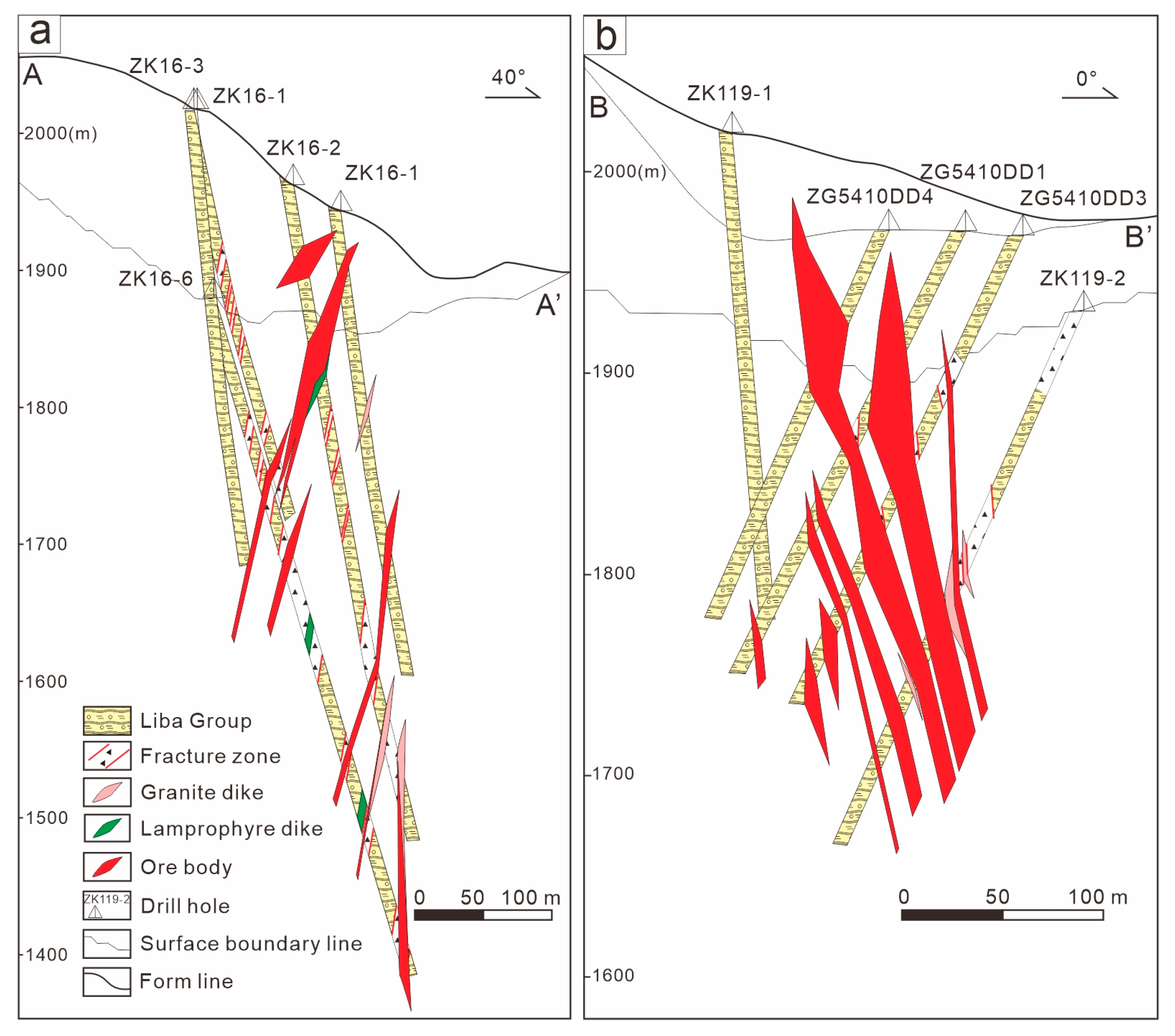


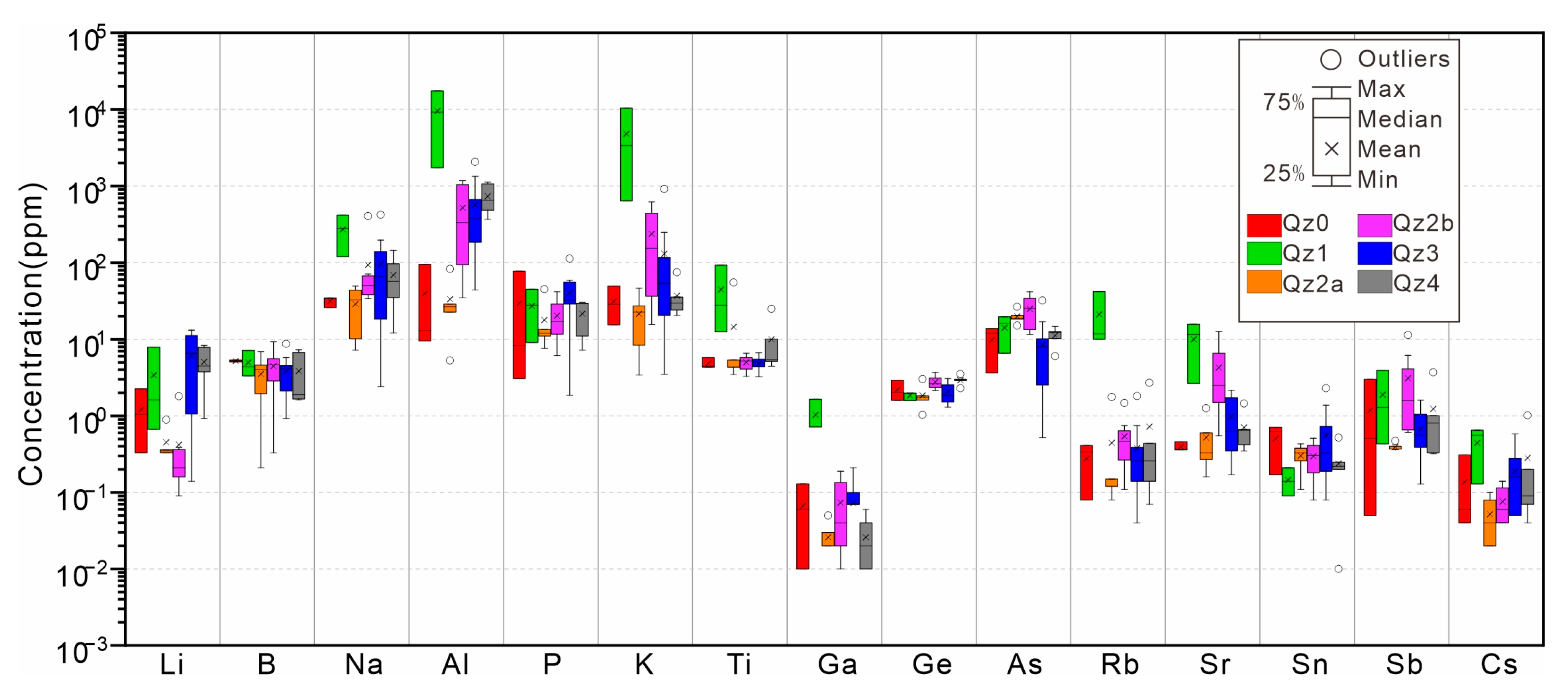
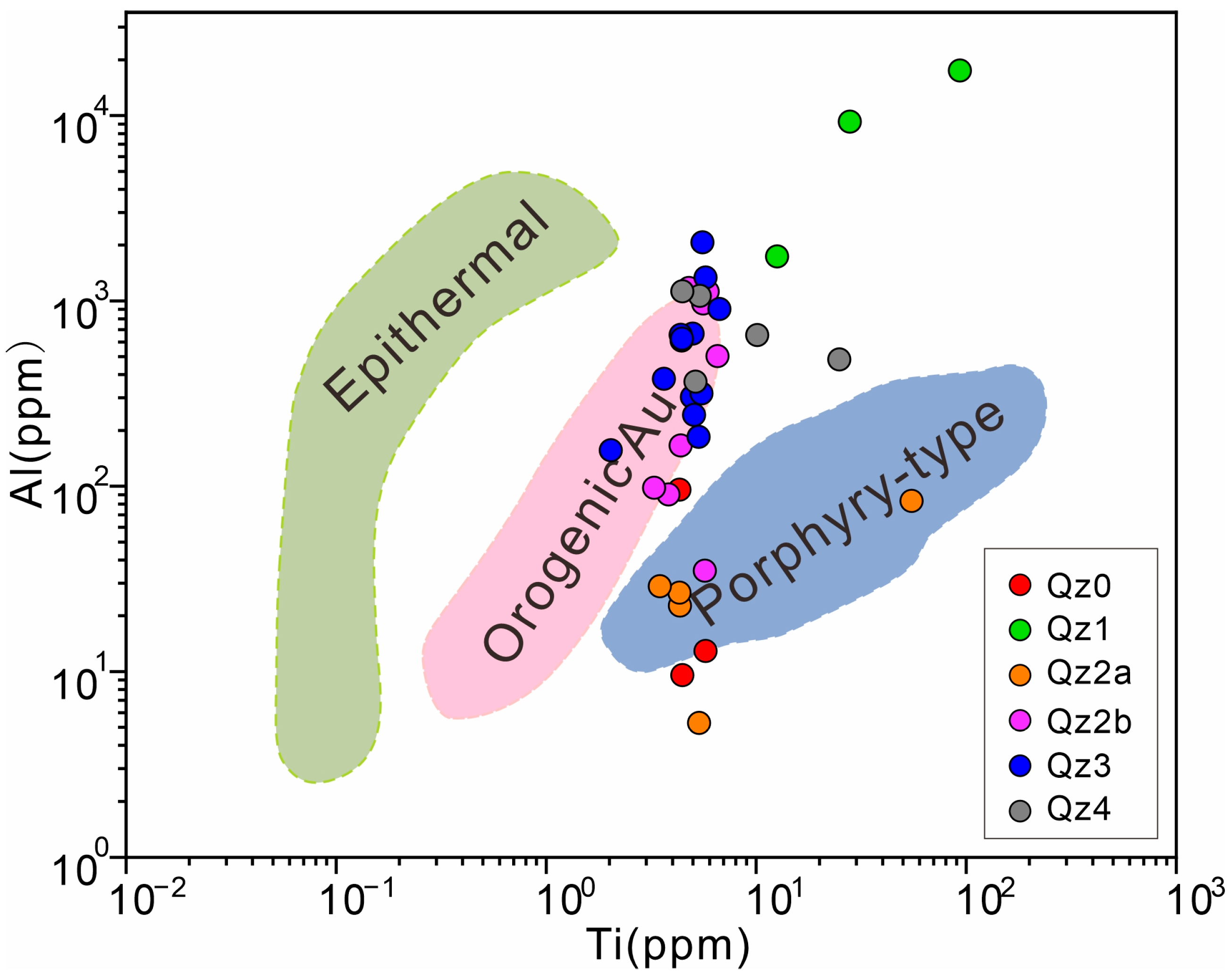
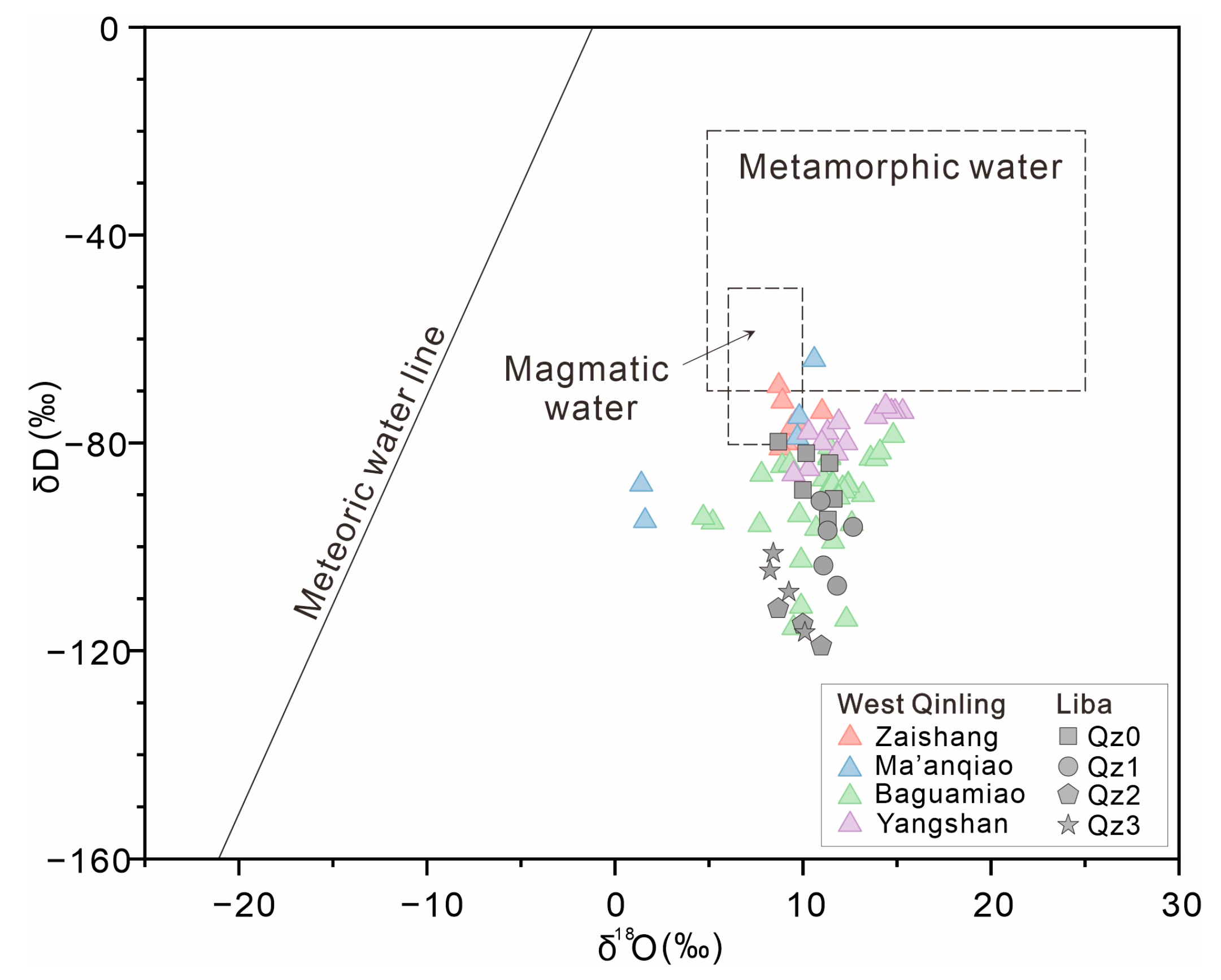
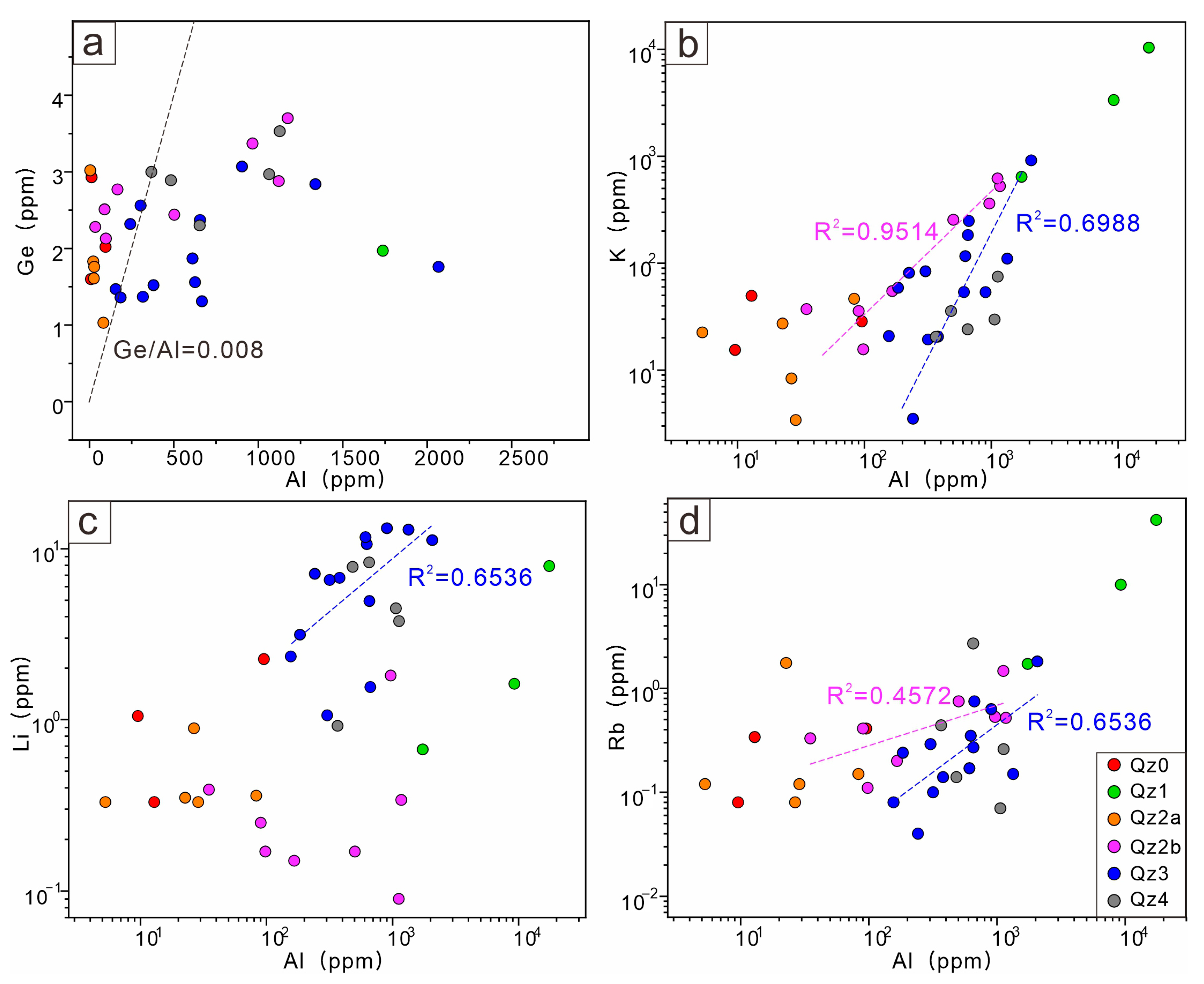
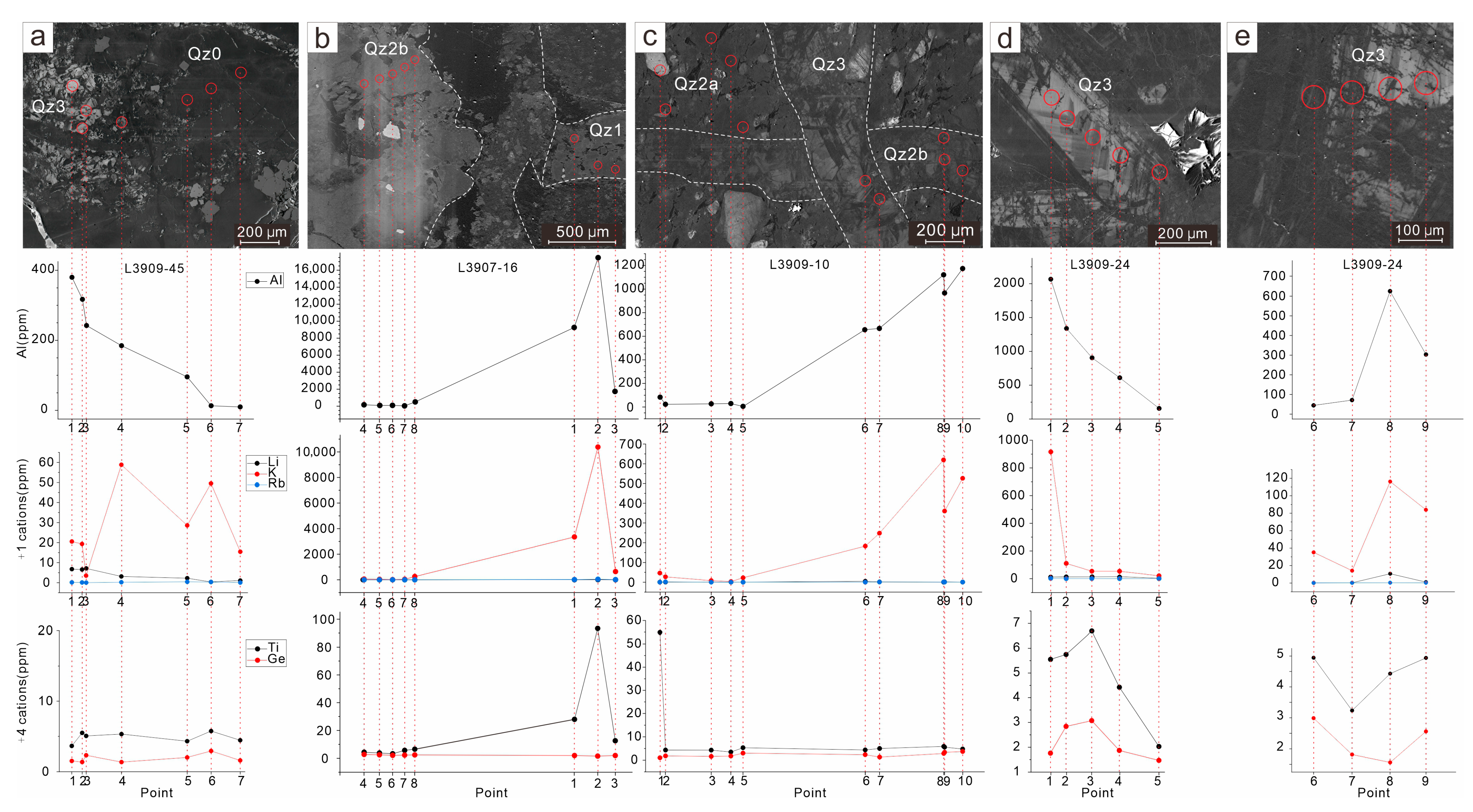
| Sample Number | Lithology | Sampling Location | Qz Type | Analytical |
|---|---|---|---|---|
| L3907-07 | Quartz vein | Zhaogou ZZK87-5, 315.3 m | Qz0 | H-O isotope |
| L3907-12 | Slate with quartz veins and pyrite | Zhaogou ZZK87-5, 122.5 m | Qz3 | H-O isotope |
| L3907-16 | Phyllitic slate | Magou MZK32-4, 163 m | Qz1, Qz2b | SEM-CL and LA-ICPMS |
| L3908-01 | Silty slate | Magou MZK32-4, 47 m | Qz2a, Qz3 | SEM-CL and LA-ICPMS |
| L3908-27 | Quartz vein | East side of platform 1833, Magou deposit pit | Qz1 | H-O isotope |
| L3908-29 | Quartz vein | North wall of platform 1833, Magou open pit | Qz0 | H-O isotope |
| L3908-30 | Slate with quartz veins and pyrite | South wall of platform 1833, Magou open pit | Qz0 | H-O isotope |
| L3908-32 | Slate with quartz veins and pyrite | West wall of platform 1833, Magou open pit | Qz0 | H-O isotope |
| L3909-03 | Slate with quartz veins and pyrite | Zhaogou ZG5210DD6, 76 m | Qz1 | H-O isotope |
| L3909-08 | Brecciated pyrite–quartz vein | Zhaogou ZG5210DD6, 134 m | Qz3 | H-O isotope |
| L3909-10 | Slate with quartz veins and pyrite | Zhaogou 99 line ZG5210DD6, 137.5 m | Qz2a, Qz2b, Qz3 | SEM-CL, LA-ICPMS |
| L3909-24 | Slate with quartz veins and pyrite | Zhaogou ZG5210DD6, 31.6 m | Qz2, Qz3, Qz4 | SEM-CL, LA-ICPMS, H-O isotope |
| L3909-38 | Quartz vein | Platform 1868, Zhaogou open pit, near granite porphyry vein | Qz2 | H-O isotope |
| L3909-45 | Siliceous vein | South of Platform 1868, Zhaogou open pit | Qz0, Qz3 | SEM-CL, LA-ICPMS, H-O isotope |
| L3909-50 | Slate with quartz veins and pyrite | West side of platform 1880, Zhaogou open pit | Qz3 | H-O isotope |
| L3911-25 | Slate with quartz veins and pyrite | Tanyaogou TZK52-2, 120.7 m | Qz2 | H-O isotope |
| L3911-27 | Slate with quartz veins and pyrite | Tanyaogou TZK52-2, 111.5 m | Qz2 | H-O isotope |
| L3911-53 | Slate with quartz veins and pyrite | Wanghe ZK51-2, 120.2 m | Qz2 | H-O isotope |
| L3911-55 | Slate with quartz veins | Wanghe TZK51-2, 137.5 m | Qz1 | H-O isotope |
| L3911-60 | Slate with quartz veins and pyrite | Madigou ZK215-2, 77.5 m | Qz2 | H-O isotope |
| L3911-61 | Slate with quartz veins and pyrite | Madigou ZK215-2, 81.6 m | Qz1 | H-O isotope |
| Samples | Types | δ18O (‰) | δD |
|---|---|---|---|
| L3907-07 | Qz0 | 11.64 | −90.80 |
| L3908-29 | Qz0 | 11.41 | −83.90 |
| L3908-30 | Qz0 | 10.00 | −89.10 |
| L3908-32 | Qz0 | 11.32 | −94.80 |
| L3911-25 | Qz0 | 10.17 | −82.00 |
| L3911-27 | Qz0 | 8.69 | −79.80 |
| L3911-55 | Qz1 | 12.67 | −96.20 |
| L3908-27 | Qz1 | 10.94 | −91.20 |
| L3909-03 | Qz1 | 11.32 | −96.90 |
| L3909-38 | Qz1 | 11.09 | −103.60 |
| L3911-61 | Qz1 | 11.82 | −107.50 |
| L3909-24 | Qz2 | 9.99 | −114.90 |
| L3911-53 | Qz2 | 10.98 | −119.10 |
| L3911-60 | Qz2 | 8.68 | −111.90 |
| L3909-08 | Qz3 | 8.42 | −101.20 |
| L3909-45 | Qz3 | 9.25 | −108.70 |
| L3909-50 | Qz3 | 10.10 | −116.50 |
| L3907-12 | Qz3 | 8.25 | −104.60 |
Disclaimer/Publisher’s Note: The statements, opinions and data contained in all publications are solely those of the individual author(s) and contributor(s) and not of MDPI and/or the editor(s). MDPI and/or the editor(s) disclaim responsibility for any injury to people or property resulting from any ideas, methods, instructions or products referred to in the content. |
© 2025 by the authors. Licensee MDPI, Basel, Switzerland. This article is an open access article distributed under the terms and conditions of the Creative Commons Attribution (CC BY) license (https://creativecommons.org/licenses/by/4.0/).
Share and Cite
Chen, Y.; Wang, Y.; Wang, J.; Li, D.; Geng, J.; Luo, J.; Wang, R. The Fluid Evolution and Metallogenic Processes of the Liba Gold Deposit, West Qinling, China: Insights from the Texture, Trace Elements, and H-O Isotope Geochemistry of Quartz. Minerals 2025, 15, 956. https://doi.org/10.3390/min15090956
Chen Y, Wang Y, Wang J, Li D, Geng J, Luo J, Wang R. The Fluid Evolution and Metallogenic Processes of the Liba Gold Deposit, West Qinling, China: Insights from the Texture, Trace Elements, and H-O Isotope Geochemistry of Quartz. Minerals. 2025; 15(9):956. https://doi.org/10.3390/min15090956
Chicago/Turabian StyleChen, Yu, Yuwang Wang, Jianping Wang, Dedong Li, Jian Geng, Jianxiang Luo, and Rui Wang. 2025. "The Fluid Evolution and Metallogenic Processes of the Liba Gold Deposit, West Qinling, China: Insights from the Texture, Trace Elements, and H-O Isotope Geochemistry of Quartz" Minerals 15, no. 9: 956. https://doi.org/10.3390/min15090956
APA StyleChen, Y., Wang, Y., Wang, J., Li, D., Geng, J., Luo, J., & Wang, R. (2025). The Fluid Evolution and Metallogenic Processes of the Liba Gold Deposit, West Qinling, China: Insights from the Texture, Trace Elements, and H-O Isotope Geochemistry of Quartz. Minerals, 15(9), 956. https://doi.org/10.3390/min15090956






